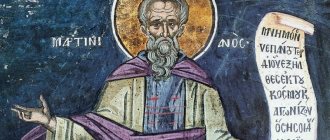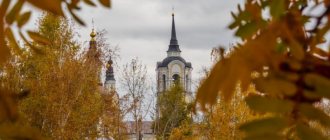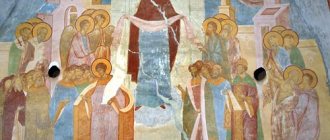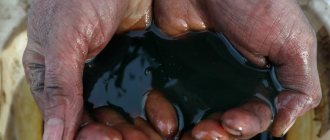October 22 is a holiday: what not to do on the holiday of the Korsun Icon of the Mother of God / ABC of Faith October 22, 2021 is a holiday of a well-fed life of health and finances.
The world celebrates International Stuttering Day
, and Russia –
Day of Financial and Economic Service of the Armed Forces
.
It's also World Capslock Day.
(Caps Lock).
According to the folk calendar, October 22 – Yakov Drovopilets. It was from this day that in the old days they began to prepare firewood for the winter.
Folk signs on October 22
- If you prepare firewood on this day, it will be warmer in winter.
- The fox barks a lot - to change the weather or rain
- During frost, the mole throws out fresh soil as it warms up.
- If the first snow falls on Yakov, then there are still forty days until winter.
- If snow fell on thawed ground, then the future harvest will be bad.
- If icicles hang from the roofs on this day, then autumn will drag on.
- If the needles have not fallen off the larch, it means there will be no snow, and if it does fall, it will quickly melt.
- If the bulbs have a lot of “clothes”, it means that the winter will be cold and harsh.
- If the cherry leaves have not fallen, it means there will be a thaw.
- If there is icy conditions, it will rain.
- Often on this day there is cereal or powder.
- Not the snow that blows, but the one that comes from above.
- It was customary to bake pies on October 22 and treat them to your family and friends. It was believed that this would ensure prosperity and good health for all these people for the coming year.
Venerable Andronicus and his wife Athanasia
The church celebrates the memory of the artisan Andronikos and his wife, who lived in Antioch in the 5th century. After the death of their children, they devoted themselves to serving God and led an ascetic life.
During the reign of the Byzantine emperor Theodosius the Great, a pious married couple lived in Antioch: goldsmith Andronikos and his wife Athanasia, the daughter of a goldsmith. They divided their increasing wealth into three parts: for the benefit of the poor, for church splendor and for household needs. After their son John and daughter Mary were born, they began to live in purity, like brother and sister. Andronicus and Athanasia were loved and revered by all citizens for their meekness and good deeds. Serving the poor, they carried the sick in their arms, washed them, fed and clothed them at their own expense, and brought peace to the poor and wanderers.
But unexpectedly, great sorrow befell them: their 12-year-old son and 10-year-old daughter died from a sudden illness. On the day of the burial of the inconsolable parents, the whole city gathered, even the patriarch himself came with the clergy. The children were buried in the Church of St. Julian. Afanasia did not want to return home and sat at the grave crying at night. At midnight, the martyr Julian appeared to her and consoled her, declaring that her dead children were now fed by the Heavenly Father, living in heaven. The touched Afanasia was filled with the desire for monastic life and upon returning home began to ask her husband for it. Having experienced it, Andronik himself desired to become a monk.
Soon Andronicus entrusted the house to Father Athanasius, saying that they were going to worship holy places and, if they were not returned, he asked that the property be distributed to those in need, and that the house be turned into a hospital for the poor and a shelter for wanderers.
Having reached Jerusalem, the couple venerated the shrines and, having accepted the blessing of the elders and talked with them, went to Alexandria to venerate the relics of the holy martyr Menas.
In the Egyptian desert, Andronik visited every Skete monastery and received from the Monk Daniel a blessing for monasticism and a letter for Athanasia to the Tavenna nunnery, where he himself accompanied her.
Having perceived the image of an angel, Athanasia began to lead an equal-angelic life here. Andronik returned to the Monk Daniel of Skete, who tonsured him to the monastic rank and, having instructed him in a virtuous life, assigned him a separate cell for practicing in silence.
After twelve years of asceticism, Blessed Andronicus begged the Monk Daniel to let him go to Jerusalem to worship. Having made a prayer, the mentor released him. And it so happened that, according to Divine dispensation, Andronicus met on the road his former wife Athanasia, who was also going to Jerusalem. However, he did not recognize her, since she was in male attire and had changed her face from the fasting life, but she recognized him and hid it, calling herself Athanasius. They continued their journey together, worshiped the holy places, and upon returning to Alexandria they decided not to be separated, but to remain in silence in the same cell, for which the Monk Daniel blessed them, calling “Athanasius” a perfect monk. After all, they lived in the same cell for 12 years in the fear of God and silence. Even then the Monk Andronik did not recognize the monk Athanasius as his former wife.
But then the time came for Saint Athanasia to depart to the Lord, and only then did she leave a letter for Abba Daniel, so that after her death he would read it himself and give it to Andronik. In this letter she revealed her secret. Soon, having received communion of the Holy Mysteries, the Monk Athanasia rested in peace. When the brethren of the Lavra, after reading the letter, learned about everything, the inhabitants glorified God. Abba Daniel summoned the inhabitants of all the Alexandrian monasteries, and the hermits in white robes honorably buried the holy body of Blessed Athanasia, marveling at her feat. And seven days later, the Monk Andronik, who was buried next to her, left for the heavenly villages after his former wife (first half of the 5th century).
Conspiracies October 22
Rejuvenation ritual
When the week departs from the Intercession, and this happens on October 22, a woman who wants to rejuvenate must go out into the yard at midnight and collect snow on her hem. The snow must be carried into your room silently and without hesitation. As you enter the room, throw snow in the middle of the room and say:
God's heavens are opening, Cold snow is falling from them. And how this snow does not have clans and surnames, And how it does not wear a pectoral cross, So that I, God’s servant, Even though I’m a hundred years old, don’t stoop, don’t grow old, Don’t have gray hair with white snow, Don’t get wrinkles, Age of youth walk around In the name of the Father and the Son and the Holy Spirit. Now and ever and unto ages of ages. Amen.
The charmed snow is not touched: it must melt and dry on the floor. The plot will not work if someone meets you or calls out to you while going for snow; if anyone asks what this puddle on the floor is and why there is snow in the house. This ritual is valid only on October 22, for seven days after the Intercession.
Yakov Drovopilets
Apostle James Alfeev.
A holiday in honor of one of the 12 apostles, brother of the evangelist Matthew. Jacob Alfeev preached in Judea, Edessa, Gaza, and Egypt. He was crucified on the cross.
Saint James Alpheus is an apostle of the 12, brother of Saint Matthew the Evangelist. After the Descent of the Holy Spirit, Apostle James Alpheus made missionary journeys together with Apostle Andrew the First-Called (November 30), preaching in Judea, Edessa, Gaza, and Eleutheropolis, converting many to the path of salvation. In the Egyptian city of Ostratsin, Saint James martyrically completed his apostolic labors by death on the cross.
Hieromartyr Konstantin Sukhov, presbyter
Dedicated to priest Konstanin Sukhov (1867-1918). He was shot by the Red Army soldiers. Canonized as holy new martyrs in 2001.
Hieromartyr Konstantin was born
The future shepherd studied at the Simbirsk Theological Seminary and on July 18, 1887, completed a full course of theological sciences. At the request of the Bishop of Simbirsk and Syzran, Barsanuphius was appointed by the Decree of the Simbirsk Spiritual Consistory as a psalm-reader in the village of Yasashnaya Tashla, Simbirsk district. On September 17, 1888, His Eminence Barsanuphius was ordained deacon of the church in the village of Mikhailovka, Sengileevsky district, and then on September 25 of the same year he was ordained a priest by the same Eminence and assigned to the village of Opalikha, Simbirsk district.
On May 17, 1890, at his own request, the young priest was accepted into the clergy of the Samara diocese and assigned to serve in the church of the village of Staro-Dvoryanovka, Samara district.
On February 1, 1896, “for the benefit of the service,” as written in the Decree of His Grace Gury (Burtasovsky; †1907), Bishop of Samara and Stavropol, Father Konstantin was moved to the village of Tsarevshchina, Samara district, where he served for more than seven years and gained the ardent love and respect of the parishioners . And here, as before in Staro-Dvoryanovka, the future martyr was both the head and teacher of the law of the local parish school. In Tsarevshchina he was awarded the second church award in his life - skufia. The first was the right to wear a legguard, with which he was awarded back in Staro-Dvoryanovka.
The Chronicle of the Life of the Village of Tsarevshchina, preserved to this day in the State Archive of the Samara Region, says:
“Father Konstantin Sukhov was loved by everyone for his ease of use and cheerful character: “With little - small, with big - big.” In days of sorrow, the priest consoled the suffering.
The local climate did not favor the Sukhov family, and illness did not bypass it either. From the metric books of the church in the village of Tsarevshchina it is known that on December 12, 1896, the four-year-old son of priest Konstantin Sukhov, Vitaly, died of diphtheria, and two months later, his daughter Nina.
On December 1, 1899, at his own request, Fr. Konstantin was transferred by Decree of Bishop Guria to the village of Uzmorye, Novouzensky district, Samara province (now in the Engels district of the Saratov region). Father hoped that in the drier and healthier climate of the Trans-Volga steppes, his family would not be threatened by infectious diseases. However, real unrest arose in the parish he left behind. Soon a whole deputation of Tsarevshchina peasants came to Vladyka Gury. The ruling bishop received the petitioners favorably and, having considered the issue, realized that Father Konstantin, who had gained such love from his flock, could hardly be painlessly replaced by someone, and on March 26, 1900, he signed a Decree on the return of Priest Konstantin to serve back in Tsarevshchina. Thus, the parishioners of the village managed to achieve the return of their beloved priest.
Father Konstantin accepted the bishop's decision with humility, realizing that he was called to serve God and people, despite hardships, illnesses and personal grief. Four months after returning to Tsarevshchina, little Vera, in whom her parents found consolation after the loss of two children, also died... Thus the Lord prepared the righteous man to accept the crown of martyrdom, leading him along the path of sorrows and humility.
But not only sorrows accompanied the life path of Father Konstantin. By the grace of God the parish grew and became stronger, more and more rural children attended the school at the church where the priest taught. Soon, in 1901, son Boris was born. This boy was to die at the age of 16, as if anticipating the martyrdom of his father. In 1902, another son appeared in the family - Leonid, who would follow his father into becoming a victim of the inhumane state system. He was repressed and shot in 1937.
In the fall of 1903, His Grace Gury, remembering Father Konstantin’s long-standing desire to change his place of residence and needing to strengthen the clergy of a remote parish, invited the priest to move to Buguruslan, then part of the Samara diocese. This time the congregation did not interfere; they finally came to terms with the desire of the Sukhov family to leave the village, where they lost three children.
On October 12, 1903, the corresponding Decree of the Ruling Bishop was issued, and Father Konstantin took the family to the place of his last and highest service “even to the point of shelter.”
In Buguruslan about. Konstantin becomes a cleric and then rector of the largest Spaso-Voznesensky Cathedral in the district; he lives nearby, on Cathedral Square. Immediately after his appointment, he represented the clergy in the city zemstvo assembly, and in 1910 Father Konstantin was already a deputy of the Buguruslan Duma. As a local citizen, he did a lot for the residents of the district, especially for the peasants.
The local branch of the Orenburg Regional Archives has preserved information that under Father Konstantin, the district zemstvo held the lead in the entire province in terms of increasing allocations for medicine. Budget amounts allocated for the protection of public health, including the fight against childhood diseases, increased 43 times. Having himself lost three children to epidemics, the priest used all the power of his pastoral influence to explain the true state of affairs with healthcare to other zemstvo residents - people who were mostly prosperous and far from the life of the common people.
The priest from the Duma tribune appealed to the conscience of legislators and often got his way. Another direction in which the Buguruslan zemstvo succeeded under Father Konstantin was the construction of grain storage facilities. According to this indicator, the district was the best in the province and one of the most developed in the Middle Volga region. The ability to preserve grown grain from dampness and fire was useful to local peasants later, during the extortionate surplus appropriation.
All his efforts to make life easier for the people only further incited hatred of the shepherd among the Bolshevik agitators with whom the district, like the entire Samara province, was swarming. What irritated the troublemakers even more was that the future martyr worked tirelessly in the field of public education: he was the head and teacher of the law of the parish school of the Ascension Cathedral, in which he served in the clergy, as well as the surrounding villages of Vasilyevka and Klyuchevka. In 1908, he opened another school in the city, where he taught the Law of God.
For his special zeal in service, Father Konstantin was awarded the last award in his earthly life - the kamilavka. His authority as a priest, educator, and intercessor for the common people grew. The Spaso-Voznesensky Cathedral in the center of Buguruslan was full not only on holidays. The wise shepherd, endowed with the rare gift of persuasion, explained to people both in sermons from the pulpit and from the Duma rostrum what the threat to the country and people was from apostasy from the Orthodox faith and betrayal of the All-Russian Autocrat.
The enemies of the Church of Christ could not tolerate this, and one day the body of young Boris Sukhov was found on the banks of the Kinel River, where his father would soon suffer martyrdom.
On February 25, 1918 - on the day of the celebration of the memory of St. Alexy, Metropolitan of Moscow and All Russia, miracle worker, Heavenly patron of the Samara region - the rector of the Ascension Cathedral, priest Konstantin Sukhov, led the procession, which, after the usual walk around the temple, went straight to the building of the Revolutionary Council, where Bolshevik leaders met. Believers thus clearly expressed their protest against the blasphemous and bloody crimes of the lawless government. Soon the new leaders, having robbed the treasury, fled from the city, harboring fear of the Orthodox people and hatred of their shepherd.
In the late autumn of 1918, after the defeat of the Czechoslovak Corps and the evacuation of the Committee of Members of the Constituent Assembly (KOMUCH) from Samara, the territory of the Samara region was captured by the Red Army. On October 22, Sunday, the advanced units of Guy’s division had already broken into Buguruslan, and mass executions of “enemies of the revolution” began. Father Konstantin Sukhov was also blacklisted.
According to the Sukhov family tradition, which is still carefully preserved by the descendants of the holy martyr, Father Konstantin was taken in the altar of the Ascension Cathedral, when he offered prayers during the Divine Liturgy for the repose of the Royal Martyrs recently shot in Yekaterinburg, and commemorated the Orthodox army opposing the atheists. The parishioners gathered, as usual, a full church. All the people followed the punishers who took Father Konstantin out into the street, begging them not to touch the priest. Despite the pleas, they took the priest in full vestments to the bank of the Kinel River, the way that he himself always walked at the head of the procession on the feast of the Epiphany. A cross-shaped hole was made in the ice - the “Jordan”, pious people immersed themselves in the Epiphany water blessed at the prayer service, and the boys released doves from their cages, symbolizing the Holy Spirit...
Father Konstantin was shot at the very place near the Kinel River where the Epiphany prayer service was held. The soul of the holy martyr soared to the Throne of God like a pure dove... The body of the martyr of Christ was thrown at the place of massacre, and the believers took it away. Nowadays, a large church has been erected on the site of the martyrdom of St. Constantine near the Kinel River.
Snow fell unusually early that year, and when the priest was being transported on a cart, his long hair fell straight into the snow and seemed suddenly gray from the frost.
On July 17, 2001, by the decision of the Holy Synod of the Russian Orthodox Church, Hieromartyr Priest Konstantin Sukhov was glorified among the holy new martyrs and confessors of Russia for church-wide veneration. His memory is celebrated on the day of his martyrdom, October 9 (22), as well as on the day of the celebration of the Council of New Martyrs and Confessors of Russia.
On October 10, 2004, by the Decree of His Holiness Patriarch Alexy II of Moscow and All Rus', a celebration was established on July 30 (August 12) in honor of all the saints who shone in the land of Samara. Hieromartyr Konstantin Sukhov is also venerated at the Council of Samara Saints.
Korsun icon: prayer
The Virgin, taken from Her birth and, after Her quiet dormition, gloriously ascended into heaven, the most humble servant of the deliverance of the world, who has sorrow in her heart for people, a close friend and comforter of all the offended, the toiling and the burdened, an indestructible support, - Now we offer you songs of praise according to our strength, Since you have shown wonderful mercy from Your image to the people of Izborsk, let us cry out to You incessantly: Rejoice, Mother of God, quick helper in times of adversity
.
***









